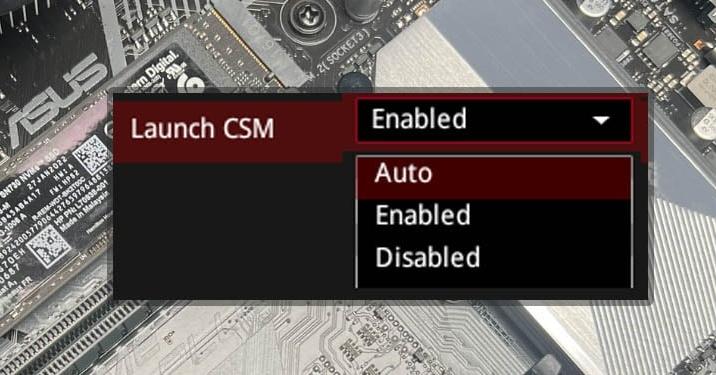Are you curious to know what is CSM in BIOS? You have come to the right place as I am going to tell you everything about CSM in BIOS in a very simple explanation. Without further discussion let’s begin to know what is CSM in BIOS?
In the ever-evolving landscape of computer technology, some terms and concepts carry hidden importance that might not be immediately apparent. One such term is “CSM” in BIOS. CSM, or Compatibility Support Module, plays a pivotal role in bridging the gap between modern computing systems and legacy hardware or software. In this blog, we will delve into the world of CSM in BIOS, understanding what it is, why it matters, and its impact on the compatibility of today’s computers.
What Is CSM In BIOS?
The Compatibility Support Module (CSM) is a feature found in many modern computer BIOS (Basic Input/Output System) setups. BIOS is the firmware that initializes hardware components, performs system checks, and boots the operating system. CSM, as the name suggests, aims to provide backward compatibility by emulating the environment of older BIOS systems, allowing them to work alongside contemporary hardware and software.
Why CSM Matters:
CSM holds relevance for several key reasons:
- Legacy Hardware Compatibility: Many older hardware components and devices, such as graphics cards, storage devices, and peripherals, were designed to work with traditional BIOS systems. CSM ensures these legacy devices can function in modern computers that use the newer UEFI (Unified Extensible Firmware Interface) BIOS.
- Operating System Compatibility: Some older operating systems, especially 32-bit versions, may not be compatible with UEFI BIOS. CSM enables these older operating systems to boot and run on modern hardware.
- Boot Option Flexibility: CSM allows users to choose between UEFI and legacy BIOS boot modes, giving them the flexibility to use either modern or older operating systems.
The Impact On Secure Boot:
Secure Boot is a security feature that ensures only trusted operating systems and software can boot on a computer. CSM can have implications for Secure Boot. If CSM is enabled, it might be easier to install or run unauthorized operating systems, potentially compromising the security offered by Secure Boot.
Enabling Or Disabling CSM:
The decision to enable or disable CSM depends on the specific requirements of the system:
- Enable CSM: If you need to run older hardware or operating systems that don’t support UEFI, enabling CSM can ensure compatibility.
- Disable CSM: If your hardware and software are all compatible with UEFI, disabling CSM can streamline the boot process and enhance security features like Secure Boot.
Conclusion:
CSM in BIOS is a bridge between the past and the present, enabling modern computing systems to communicate with legacy hardware and software. While UEFI BIOS has brought about significant advancements in boot speed, security, and functionality, CSM plays a vital role in maintaining compatibility for older components and operating systems. Whether you’re building a new system, upgrading hardware, or exploring the intricacies of BIOS settings, understanding CSM’s role will help you make informed decisions about compatibility, security, and the overall performance of your computer.
Learn more about similar topics like these on Clynerr.
FAQ
Should CSM Be Enabled Or Disabled?
To put it in a nutshell, CSM exists to provide compatibility with systems that support or do not support UEFI completely, as well as systems that must be installed in Legacy. Therefore, if you need to boot a traditional MBR device, you need to enable the CSM.
Should I Turn On CSM In BIOS?
For example, if you are running Windows 10 then it already supports UEFI which means you don’t need to enable CSM on PCs running Windows 10. However, if your PC is running Windows XP or other legacy operating systems then you need to enable CSM in order for it to support UEFI.
Should I Run In CSM Or Uefi?
Ultimately, the choice between CSM and UEFI BIOS comes down to drive size support and compatibility. If you have a new computer with a large drive, you will need to use UEFI mode. However, if you have an older computer with a small drive, you can use either mode.
What Does CSM Do?
A customer success managers (CSM) supports your customers as they transition from sales prospects to active users of your products. They’re focused on customer loyalty and building close long-term client relationships, and often stay with the same customers as long as they continue to work with your business.
I Have Covered All The Following Queries And Topics In The Above Article
What Is CSM In BIOS
What Is CSM Support In BIOS
What Is Launch CSM In BIOS
What Is CSM Support In Gigabyte BIOS
What Is CSM In The BIOS
What Is CSM In Asus BIOS
What Is CSM Option In BIOS
What Is Legacy Mode CSM In BIOS
What Is CSM In BIOS Asus
What Is Computer CSM In BIOS
In Asus BIOS What Is CSM
What Is Launching CSM In BIOS For
What Is Enable CSM In BIOS
What Is CSM In My BIOS
What Is Launch CSM In Gateway BIOS
What Is Launch CSM In BIOS Mean
What Is CSM Setting In BIOS
What Is CSM In Asus BIOS Options
What Is CSM In BIOS?
What Is CSM In BIOS Utility
What Is CSM Mode In BIOS
For What Is Use Lunch CSM In BIOS Asus
What Is CSM Function In BIOS
What Is CSM Stand For In BIOS
What Is CSM In Uefi BIOS
What Is CSM In BIOS
Should I run CSM or UEFI
